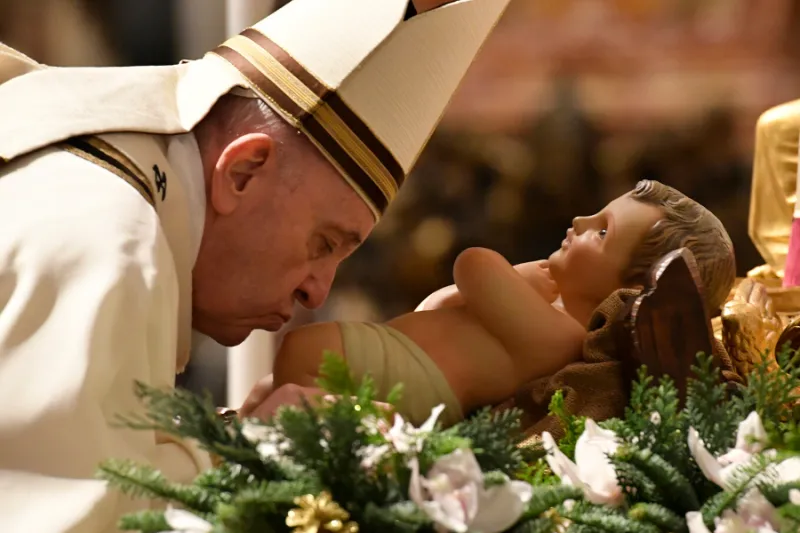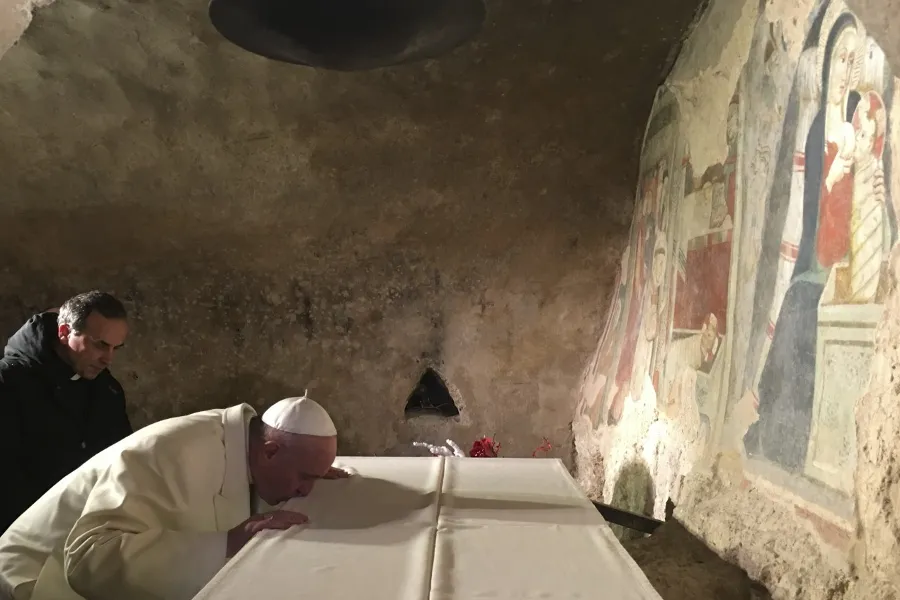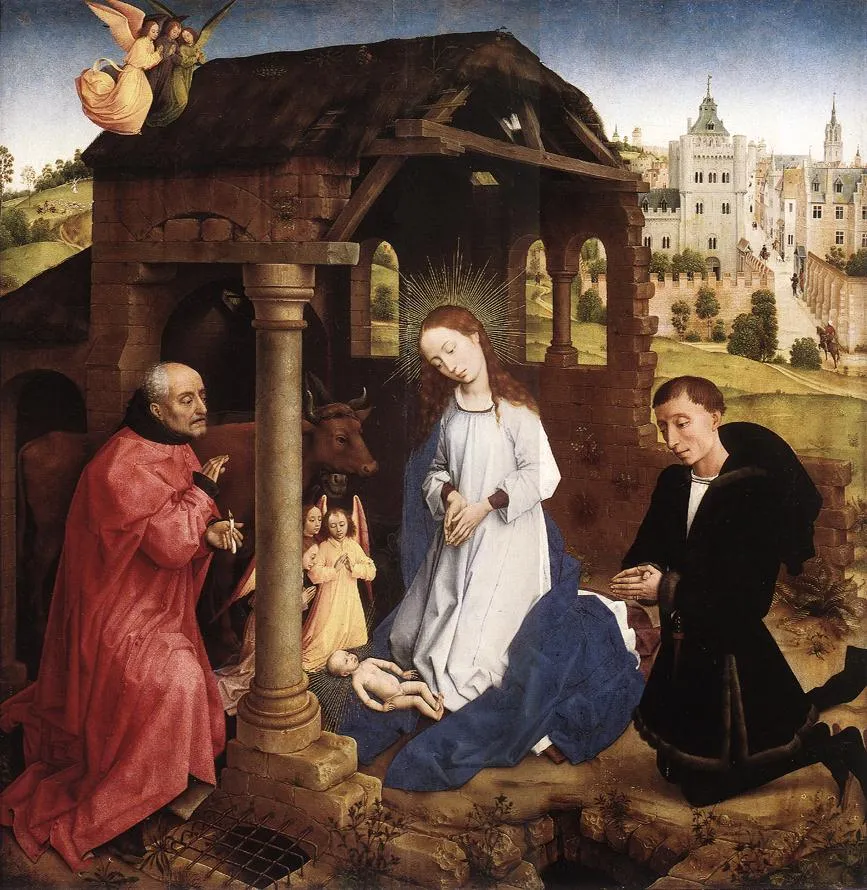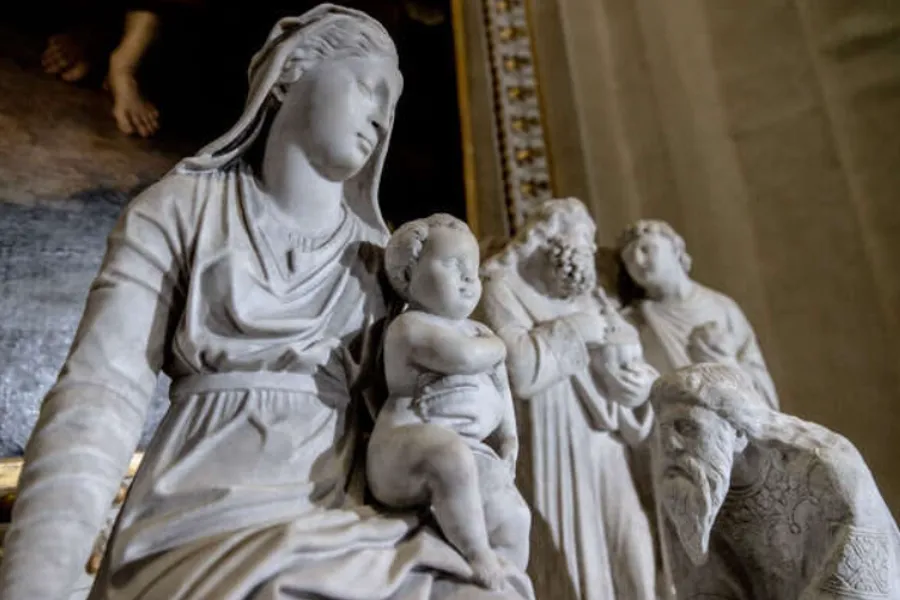
Renowned worldwide for his radical poverty and profound humility, St. Francis of Assisi is among the most famous of God’s saints. It is no wonder, then, that, like his master Jesus of Nazareth, Francis has been misunderstood and deliberately misappropriated for various causes that depart from—and often ignore—the singular cause that inspired Francis’s every move: unquenchable love for God.
Francis’s inimitable holiness has won the esteem of people across religious and geographic boundaries for eight centuries. Yet this holiness is blinding for those who cannot comprehend that someone would go to such unspeakable lengths for God. As was done to Jesus before him, different ages have made efforts to refashion Francis into someone more respectable for the non-religious elite, to abstract the virtuous acts from their religious origins. Such has been the popular fate of the Poor Man of Assisi.
Controversy over Francis and his legacy is not a modern phenomenon. Even within Francis’s own lifetime, there were conflicting interpretations over how his rule ought to be lived. Shortly after Francis died, his order divided, with a group called the Spirituals, who demanded a more rigorous living of the rule, opposed to the Conventuals, who interpreted the rule more moderately. Divisions would continue to appear over the centuries between men and women who all have called themselves Franciscans, and who all have thought they were living according to their master’s will.
The modern epoch has sought to strip Francis of his religious zeal, just as it has deliberately ignored Jesus’ divinity in reducing Him to a “great moral teacher.” Today, popular convention portrays Francis as a tree-hugging hippie devoted to the causes of nature and of peace. Take, for example, the “Prayer of St. Francis,” which was not composed by Francis, but by an anonymous French writer in the early 20th century. It never mentions God or Jesus by name, and, true to the modern spirit, it puts disproportionate emphasis on the self: “Lord, make me a channel of your peace. Where there is hatred, let me bring love.” Now set to a sappy musical melody, it is hard to imagine the firebrand Francis strumming his lyre to this one. The saint sang a different tune in his Regula Prima, 17: “Let us refer all good to the Lord God most High and Supreme; let us acknowledge that all good belongs to Him, and let us give thanks for all to Him from whom all good proceeds.”
Then there is the famous saying attributed to St. Francis: “Preach the Gospel. When necessary, use words.” It is possible to mistake this maxim as absolving us from the need to speak about Christ to others. Francis, in fact, said no such thing. He did exhort his Friars, “Let all the brothers preach by their works” (Regula Prima, 17). What Francis wanted was for his men’s actions to live up to the Gospel they were preaching. He did allow his Friars living among the Saracens “not to make disputes or contentions” if they confessed to being Christians.
But the first Franciscans were hardly cruising the Mediterranean Sea in a boat whose bumper sticker read “Coexist.” Rather, Francis urged, “when [the Friars] see it is pleasing to God, they announce the Word of God, that [the Muslims] may believe in Almighty God,—Father, and Son, and Holy Ghost, the Creator of all, our Lord the Redeemer and Savior the Son, and that they should be baptized and be made Christians, because, ‘unless a man be born again of water and the Holy Ghost, he cannot enter into the kingdom of God’” (Regula Prima, 16). The first Franciscan martyrs gave their lives while trying to convert the Muslims in Morocco in 1220.
More recently, popular cinema has co-opted Francis to advance new age ideas in Franco Zeffirelli’s 1972 film “Brother Sun, Sister Moon.” The wise encyclopedists at Wikipedia saw through this move: “The film attempts to draw parallels between the work and philosophy of Saint Francis and the ideology that underpinned the worldwide counterculture movement of the 1960s and early 1970s.” Lest we think that Francis gave up on the Church for a more emotive, spiritualized Christianity, we can read his Second Letter to the Faithful:
We must also frequently visit churches and venerate and revere the clergy not so much for themselves, if they are sinners, but because of their office and administration of the most holy Body and Blood of Christ which they sacrifice upon the altar, receive and administer to others. And let all of us know for certain that no one can be saved except through the holy words and Blood of our Lord Jesus Christ which the clergy pronounce, proclaim and minister. And they alone must minister and not others.
Finally, we cannot forget Francis the nature lover. Around Francis’s feast day each year, Christian churches of all denominations offer a blessing of animals. It is certainly true that Francis loved animals and nature. But as biographer André Vauchez correctly notes, Francis’s attitude “did not flow from a sentimental compassion or from any pantheistic fervor” that marks the animal rights and the radical environmentalist movements of today. Rather, his famous Canticle of the Creatures, which is quoted to open Pope Francis’s encyclical Laudato Si, is very clear that the brilliance of nature lies in its reflection of God: “Praised be You, my Lord, through Sister Moon and the stars, in the heavens you have made them bright, precious and fair. Praised be You, my Lord, through Brothers Wind and Air.”
Nature and animals, for Francis, are not an end in themselves, but a reminder of God’s glory. Such was his mindset when he cursed a sow for killing a lamb, whose slaughter reminded Francis of Christ: the sow immediately fell ill and died three days later.
How, then, can we recover the real Francis? By reading his writings. There we will find not a Woodstock spiritualist, but a faithful man devoted to the holy Church of God; not a minimalist in religious matters, but a maximalist who saw to it that churches and altars sparkled for God; not a sentimentalist, but a lover of the holy Eucharist; not a chartering member of PETA, but a man who understood the hierarchy of creation; not a man “tolerant” of all religions, but certain that Catholicism was the one true religion; not a man given to niceties, but to mortification and suffering for Christ whose five wounds he was asked to bear in his own flesh.
In the 13th century, God called Francis to rebuild His Church. If we are to rebuild our own tattered Church in the 21st century, the only way forward is in the footsteps of the real Francis of Assisi.
(Editor’s note: This essay was originally published by CWR on October 3, 2020.)
If you value the news and views Catholic World Report provides, please consider donating to support our efforts. Your contribution will help us continue to make CWR available to all readers worldwide for free, without a subscription. Thank you for your generosity!
Click here for more information on donating to CWR. Click here to sign up for our newsletter.















Excellent article, and I enjoyed the irony of “The wise encyclopedists at Wikipedia.”
Indeed. Please avoid using wokepedia as a source of information. It is not scholarly and it is biased vs Christians. Use instead scholarly sources. For a short moving and precise bio of St. F see the Catholic Encyclopedia New Advent. See link below. Catholic Encyclopedia New Advent on St. F uses real scholarly researchers (at the bottom you can see them listed) and not “editors”. For exposes of the bias of Wokepedia see links below. And yes, St. Francis of Assisi, pray for us.
Catholic Encyclopedia New Advent on St. F:
https://www.newadvent.org/cathen/06221a.htm
Exposes of wokepedia:
https://www.youtube.com/watch?v=OU1_PY_omtc
https://www.conservapedia.com/Wikipedia
https://www.breitbart.com/tech/2025/09/26/wikipedia-editors-spread-lies-about-charlie-kirk-following-assassination/
Wikipedia Editors Spread Lies About Charlie Kirk Following Assassination
Do you imagine that the writers of the century-old old Catholic Encyclopedia didn’t have their biases, too? Wikipedia articles are a work in progress, perpetually corrected by users.
The Augustine Thompson biography cited below is an excellent, scholarly source.
Yes, the Thompson book is very good. The bias and even lies of wokepedia has been demonstrated. See
https://www.breitbart.com/tech/2025/09/26/wikipedia-editors-spread-lies-about-charlie-kirk-following-assassination/
Wikipedia Editors Spread Lies About Charlie Kirk Following Assassination
https://www.youtube.com/watch?v=OU1_PY_omtc
https://www.conservapedia.com/Wikipedia
I cannot recommend more highly Augustine Thompson’s 2012 contribution: “Francis of Assisi: A New Biography.” The scholarly Dominican gives a sober, reverent recounting of the life of Saint Francis with critical analysis. If you come to it with some familiarity of Francis this will sharpen your lens and reveal the man behind the poetry and birdbaths. It left me with a renewed reverence — I felt as if I had met him for the first time — the real Francis with some warts and all which only enhance the Christ-like Umbrian mystic.
Another good book is the more recent bio by Andre Vauchez. Published in France, it won the Prix Chateaubriand. It is now available in English at amazon. It is indeed a formidable work by a medievalist scholar. Some reviewers point out that it has the additional advantage of not being written by a member of a religious order (the Dominicans) that had long been in rivalry with the Franciscans. Thompson is a Dominican, and his book does seem to play down the extraordinary figure of St. Francis, depicting him more like “an ordinary Italian who accomplished extraordinary things” and dismisses miracles like that of the voice that spoke to Sf at the chapel, or the miracle of the wolf of Gubbio. For my taste, the best bio is still the first one, by SF fellow Franciscan Thomas of Celano, who knew him personally as one of his early followers. Someone who joined out of devotion to the Lord is unlikely to have sinned by lying in writing about SF life and miracles. The bio is available at amazon.
Blessed Feast Day to our Holy Father too ..who likely took that name , inspired by The Spirit for any # of reasons , ? including the love and esteem of the saint for The Church and the priesthood , in spite of having been in a Papal Jail , after having been captured as a knight ( as mentioned in this other good article –
https://www.crisismagazine.com/2020/the-francis-option .)
The desire and the wisdom to discern God’s Will , to be faithful to same , struggling against the self will that wants to reign , as an effect of The Fall – the common thread that seems to run in these icons of holiness that God mercifully presents to us as helpers ..
That mercy of The Lord , to bless us with the Reign of The Divine Will – seems God has been preparing same for our times , when the effects of the self will have been like in the flood of Noah , including in attitudes towards the Father figures in The Church …
Another ‘Little ‘ yet mighty warrior chosen by The Lord ,as a sign of contradictions , often also misunderstood , yet not bitter , blessed with miracles of deliverance from plagues for the afflicted area ; one of her spiritual Fathers also a St. of related name – At.Annibale De Francia –
https://bookofheaven.com/introduction/biography/
The Holy Father has also done for good in his words of wisdom about pet ownership , to help families who might struggle with the little self wills of the little ones demanding pets , using St. Francis as the excuse – 🙂
https://www.catholicnh.org/assets/Documents/Worship/Our-Faith/Understanding/PopeFrancis-Pets.pdf
The glorious role that The Father has willed for us His children ,as The Divine Will – may the light of same help us too, to see the true destiny and identity of each of us too .
Blessings !
Or the name of Francis, the image of Christ Crucified, has been more likely adopted as a matter of subterfuge, appealing to an erroneous birdbath sham promoting “pet ownership”, Marxist globalization, false ecumenism, liturgical abuse, gender dysphoria and an endless cacophony of dissonant notions.
Francis was a disciplined clearsighted realist immersed in the person of Jesus Christ, steeped in deep prayer and authentic Roman Catholicism. He would find no comfort in the follies featuring the Argentinian Jesuit.
Trying to discern how Mr . Carl Olson might answer ..
since there are lots more now, named after and with the Heart of St.Francis , would it be like
‘ here P.G . , P.G . , P.G . ‘ – invoking the charism of the occasion of the taming of Gubio , except in our times , ? more in packs .. 🙂
Pope Emer . , who loves cats ,likely calling the tune too .. 🙂
St.Dominic , we need your prayers too !
Me alegro de encontrar esto…Es mi convicción también de que la imagen del Seráfico Padre ha sido tergiversado…todo confluye en el naturalismo del que padece la parte modernista infiltrada en la Iglesia actualmente.
Buen artículo. Pero es de no olvidar que el papa Bergoglio adoptando ese mismo naturalista itinerario pretender “hacerlo efectivo” y pronto.
St. Francis is titled “Seraphic” because of the Stigmata he received. This is completed on earth and in heaven. It can’t suffer “distortion”.
Maybe someone has a mind to hurt the Franciscan community. St. Francis warned about that.
But in fact the Modernist heretics target everything, not just religion or a part of the Roman Church. So far the Holy Father has not raised the warning.
Don’t forget Chesterton’s biography. It is inspiring, and as good as anything else he did.
Yes, indeed it is, and the best “anything else” would be his
biography of the “Dumb Ox,” St Thomas Aquinas
We have in our age reached a breaking point in the life of The Church at which something happened to St. Francis that remain repulsive and greatly dark to most of us, who are ordinary and selfish men whom God has not broken to make anew.
“The transition from the good man to the saint is a sort of revolution; by which one for whom all things illustrate and illuminate God becomes one for whom God illustrates and illuminates all things. It is rather like the reversal whereby a lover might say at first sight that a lady looked like a flower, and say afterwards that all flowers reminded him of his lady. A saint and a poet standing by the same flower might seem to say the same thing; but indeed though they would both be telling the truth, they would be telling different truths. For one the joy of life is a cause of faith, for the other rather a result of faith”. G. K. Chesterton observes.
“He saw things go forth from the divine as children going forth from a familiar and accepted home, instead of meeting them as they come out, as most of us do, upon the roads of the world. And it is the paradox that by this privilege he is more familiar, more free and fraternal, more carelessly hospitable than we. For us the elements are like heralds who tell us with trumpet and tabard that we are drawing near the city of a great king; but he hails them with an old familiarity that is almost an old frivolity. He calls them his Brother Fire and his Sister Water. So arises out of this almost nihilistic abyss the noble thing that is called Praise; which no one will ever understand while he identifies it with nature-worship or pantheistic optimism. When we say that a poet praises the whole creation, we commonly mean only that he praises the whole cosmos. But this sort of poet does really praise creation, in the sense of the act of creation. He praises the passage or transition from nonentity to entity; there falls here also the shadow of that archetypal image of the bridge, which has given to the priest his archaic and mysterious name. The mystic who passes through the moment when there is nothing but God does in some sense behold the beginningless beginnings in which there was really nothing else. He not only appreciates everything but the nothing of which everything was made. In a fashion he endures and answers even the earthquake irony of the Book of Job; in some sense he is there when the foundations of the world are laid, with the morning stars singing together and the sons of God shouting for joy. That is but a distant adumbration of the reason why the Franciscan, ragged, penniless, homeless and apparently hopeless, did indeed come forth singing such songs as might come from the stars of morning; and shouting, a son of God. This sense of the great gratitude and the sublime dependence was not a phrase or even a sentiment; it is the whole point that this was the very rock of reality. It was not a fancy but a fact; rather it is true that beside it all facts are fancies. That we all depend in every detail, at every instant, as a Christian would say upon God, as even an agnostic would say upon existence and the nature of things, is not an illusion of imagination; on the contrary, it is the fundamental fact which we cover up, as with curtains, with the illusion of ordinary life. That ordinary life is an admirable thing in itself, just as imagination is an admirable thing in itself. But it is much more the ordinary life that is made of imagination than the contemplative life. He who has seen the whole world hanging on a hair of the mercy of God has seen the truth; we might almost say the cold truth. He who has seen the vision of his city upside down has seen it the right way up,” GK Chesterson who undoubdtedly presents a timely biography of St. Francis for our times.
In a St Francis that should rightly be born every 500yrs and grace our midst, Jesus Christ comes anew into the world, builds His Church in hearts crucified to the desires of flesh and the physical Church as for reparations-not for a seat of honour at the seat of satan, and spreads His love by friendship it learnt in faith and faithfulness.
St. Francis of Assisi – Pray for us.
I wonder what would St. Francis (named in 1979 by St. Pope John Paul II as the patron saint of ecology) say to those who take the position of the big-oil-driven right-wing and conservative indifference or denialism to the reality of man-made environmental destruction today.
That they aren’t indulging in pantheism and wailing about “Gaea,” but instead are reading actual science?
“Denialism to the reality” my foot.
Please stop. St. Francis would probably confront the deluded people who believe in “climate change” and use it as a front to advance their leftist agenda. You’re the one sounds like he’s pretty stuck in denialism
If you travel to Harrisburg, PA, the State Museum houses the state fossil. That fossil is a Mastodon found near a Stroudsburg. Part of the broad class of extinct animals known as Pleistocene megafauna, this particular specimen may have been among the last of its kind. It is surmised that it perished due to the warming that occurred, making Pennsylvania temperate, rather than glacial. I’m fairly certain that human campfires did little to warn the earth when that epoch ended 12,000 years ago.
Lan, environmental destruction & waste are nothing new. I’m pretty sure St. Francis would have been familiar with the varieties common to his era.
We have a better understanding of conservation today. I think St. Francis would be pleased with the progress we’ve made in our understanding & appreciation of Nature & conservation of wildlife & habitats.
A relative of mine was a professor, scientist, an early environmentalist , whose reputation was blacked and life threatened by big chemical companies because he dared to publish a study proving the link between the use of their chemicals on living tissue- DDT . The university tried to silence him because the chemical industry gave them enormous research grants. His work was part of the basis of Rachel Carson’s book “Silent Spring” which sparked public interest in saving the environment in the early sixties. The same thing is happening today. Just follow the money. Modern deniers get your head out of the sand. Truth is above politics.
WAKE UP DENIERS THE CLOCK IS TICKING and accountability is waiting!!!
“I call everyone who disagrees with me a climate denier. But don’t label me a liberal.” 🙄.
Many rightists (not all) completely deny any climate change caused by human greed and neglect. They also deny the need for environmental research and conservation. They want to allow private companies to rape our Nation’s protected lands and natural resources for profit. They label us as liberal communist tree huggers.
Denial of what?
Francis would probably be as puzzled by your nonsense as we are.
A
Good question!
I very much emjoyed Frank M. Rega’s St Francis of Assisi and the Conversion of the Muslims (2008, TAN Books). IT dispels the myth of St Francis being some kind of hippie pacifist and instead shows the “real” St Francis, a zealous defender of the Faith who risked his life in an attempt to convert Muslims during the Fifth Crusade. He laos apparently invented the Nativity Scene (with real animals, no less).
To Lan Baode: pejoratives like ‘big oil’, ‘right wing’ and ‘conservative’ are not suitable. Having worked for Exxon I can say that none of these terms remotely reflect the thinking or motivations of the directors of a company. These terms may be the imaginings of journalism, and sometimes academia, to impute evil. However, the personal ideologies of the directors of large corporate entities tend to be left wing and progressive. But, this does not matter because all ideas that threatened the flow of product, the only real issue, would be quickly rejected. The people who run large business are technologists and not ideologists.
About left-wing corporate boardrooms, technologists, and St. Francis—three points:
FIRST, we need not forget that in 2015 the corporate gurus flooded the U.S. Supreme Court with some 400 amicus briefs in support of gay “marriage.” As broadly reported and rewarded in the media, AT&T and Verizon, Dow Chemical, Bank of America, General Electric, Coca-Cola and Pepsi, Google, Apple, Facebook and Microsoft, and the San Francisco Giants headed the list.
SECOND, all of us might recall G.K. Chesterton who clarified with St. Francis that Nature is not our Mother, but only our “sister.” Which is to say that, unlike the Triune God who is infinite and One, Sister Nature if finite and complex. That is to say, further, that the pagan female idol depicting hundreds of engorged breasts for our exploitation might not be accurate.
THIRD, so, the Christian St. Francis might not have knee-jerked against the possibility of ‘climate change” from a mix of both natural and even some anthropogenic causes. His message to the Sultan was conversion and not a convergence of indefinite “fraternity,” nor today would he settle for the boardroom ethics of infinite-pronoun gender theory nor the other inventions of leftist ideology—such as glossing over the real complexities and vulnerabilities of natural ecology. the bobble-head business as usual.
SUMMARY: St. Francis had sympathy for particular critters like real birds, and probably including those carcasses found around empty water holes in 13th-century Egypt. Today in the 21st Century, and different from the saccharine image of bird baths, he might also notice the desertification of the Sub-Sahara and that the Dust Bowl actually happened…
In short: the catechism teaches us that we are called to be good stewards, not dominators of creation.
” These terms may be the imaginings of journalism, and sometimes academia, to impute evil.”
You forget the garden variety leftist shill. The left’s perpetual revolution requires enemies and since the left’s indignities are itinerant and transient, amorphism is a useful feature-when they inevitably wish to deny, modify or repute their position.
And why not check out the wonderful opera on the life of Francis by the great composer Messiaen, a faithful and devoted Catholic.
Apologies for the ignorance of the deeper details in the life of the St , esp. in the area of the ‘Father wound’ ..unsure if he ever reconciled in person in this life with his father … ? was such if present,also at the root of the demonic assaults against purity.. God revealing His goodness through such too , to bless him
to also earn merits for our times when such is ramapant – as bitterness, the spirit of rebellion , unholy soul ties , even in places where it ought to be the least..
? all such , in turn as occasions of getting ‘accursed ‘ – for ‘preaching another gospel’ against His Holy Will – in the responsibility to love others with the Holy Spirit purity , in The Mother .. she , who loved God, thus ever loving His Holy Will, to be attentive / obediant to same ….how much our times need the same grace through her .. ? same being another good reason that the Holy Father chose the name, to also help break the seals around hearts – as the loss of grace to repent..
Thank God for the curse breaking prayers and related ones through the ministry of exorcism –
https://www.catholicexorcism.org/post/exorcist-diary-209-satan-s-spirit-of-rebellion
https://www.youtube.com/watch?v=sEWEvCxEvK4 – the curse breaking prayers at the 35-45 min can be repeated often enough , after having listened to the talk once .
May all such help to fulfill all the noble prayer intentions of the Holy Father , including for this month .
My memorable St Francis of Assisi moment was ascending misty Mt Alverna where he received the stigmata. Rarely have I felt the shudder of what he experienced among the dark, dank, great slabs of brute stone piled upon another apparently erosion Gothic in appearance. Lost out there somewhere days of lonely prayer, interior dialogue with God’s Son.
Romanticism seemed childish. This was a death battle with life, the Satanic, all that has desirability, all that must be vanquished. He reentered our known world crucified.
St. Francis of Assisi pray for us on your Feast Day.
Now if we can get the OFMs to return to the Catholic faith…